Shutting down a walk-in cooler can feel like a nightmare. Routine maintenance may seem time-consuming, and repairs often look expensive. But can you afford to let your walk-in box run at high temperatures and risk food spoilage?
How can you reduce downtime and lower maintenance costs for your walk-in coolers and freezers?
Fortunately, simple actions—like regular tune-ups—can help minimize commercial walk-in refrigerator issues, keeping your box temperature stable and reducing costly emergency service calls.
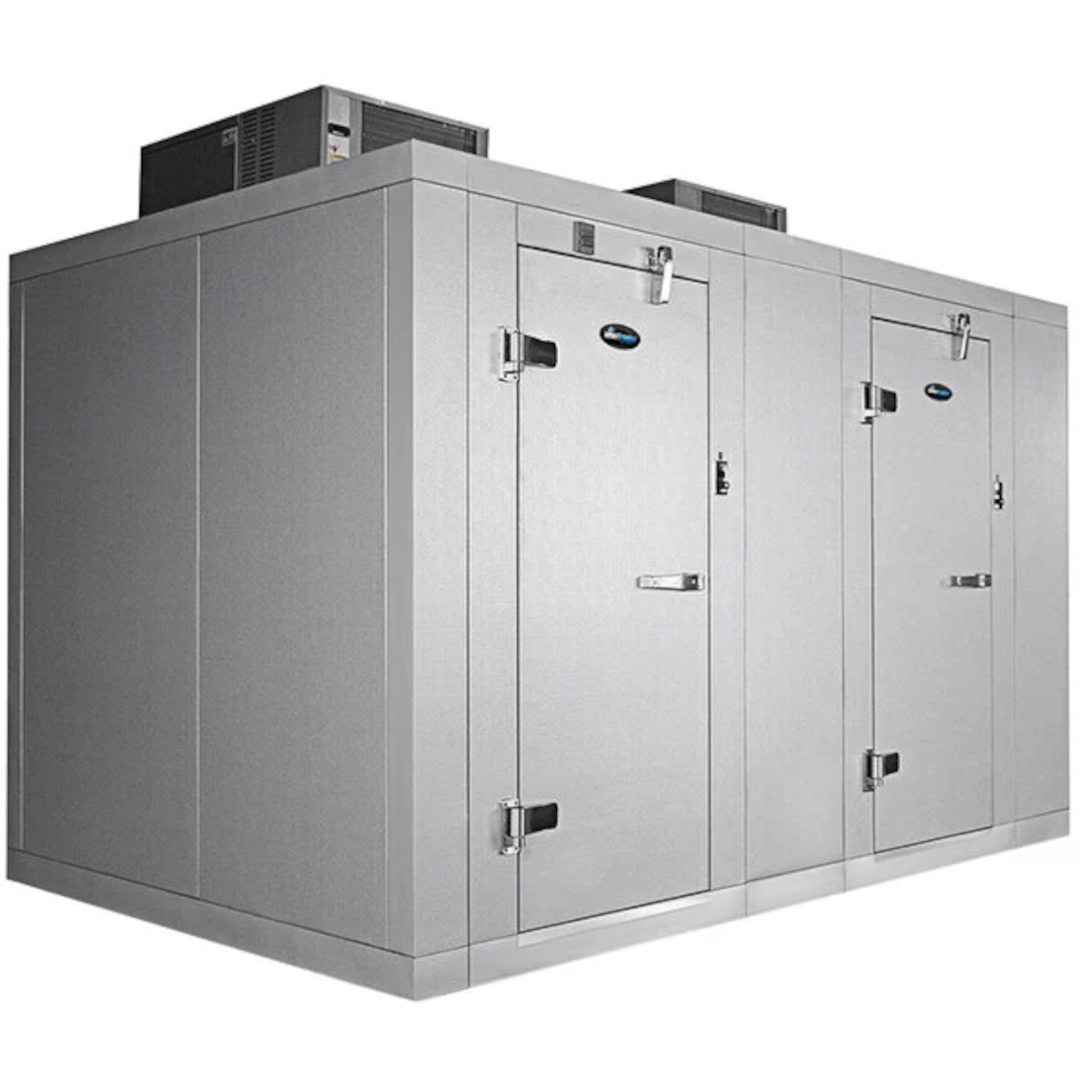
Many business owners tend to overlook basic maintenance until an emergency repair is needed. Tackling these issues proactively can help you avoid costly repairs and keep your equipment in optimal condition.
We’ve compiled and consolidated maintenance recommendations from several walk-in cooler manufacturers, combined with our 20 years of field service experience, into a concise list. We’ve broken it down into DIY maintenance tips and advice on when to call a professional.
To help you better understand, we’ll also explain the differences between walk-in coolers and freezers, their components, temperature requirements, common cold-storage room problems, recommended solutions, equipment life expectancy, and the importance of regular maintenance.
The following is a list of the bare minimum maintenance requirements for cold storage rooms to keep them functioning properly and reduce repair expenses.
DIY Tips for Walk-in Cooler & Freezer Maintenance
Maintaining your walk-in box is crucial to ensure its efficiency and longevity. Here are some DIY tips and best practices to keep your walk-in box in top condition:
A professional-grade tuneup list is provided. Based on years of experience, good HVAC technicians have trained eyes and measuring instruments to spare owners lots of headaches and can help them prevent costly shutdowns.
Best Temperatures for Walk-in Boxes
One frequently asked question is, "What is the best temperature for a walk-in?"
It’s important for equipment owners to follow the guidelines set by local health departments. The FDA (Food and Drug Administration) requires that food be stored below 40°F (4°C) to ensure food safety. For practical purposes and to meet most requirements, complying with NSF/ANSI Standard 7 and other relevant standards for walk-in refrigeration equipment.
| Box Type | Best Temp | Range | Comments |
|---|---|---|---|
| Walk-in Cooler | 35°F | 34°F to 40°F | Ideally, 35°F to 38°F. Below 34°F, food freezes; above 40°F, lower food life, and danger zone. |
| Walk-in Freezer | -10°F | -10°F to 0°F | As long as the food is frozen solid, the FDA recommends -10°F. |
| Walk-in Ice Cream Freezer | -18°F | -20°F to -10°F | Optimize for the quality of the food and demand. Higher temperature reduces compressor run time and lowers energy bills. |
Difference Between Walk-in Cooler and Walk-in Freezer
While they share many common components, the first key difference between a walk-in cooler and a walk-in freezer is their operating temperature. A cooler operates between 34°F and 40°F, while a freezer operates below the freezing point. Consequently, walk-in freezers require larger components, more parts, and greater care from installation to maintenance.
Both evaporator coils in coolers and freezers can drop below freezing, causing moisture in the air to condense on the evaporator fins. If untreated, this will form ice, blocking airflow and preventing the system from cooling effectively. To address this, manufacturers equip these systems with defrost timers to melt the ice and prevent excessive ice buildup. The melted ice becomes water, which must be drained to prevent flooding and further ice buildup when the cooling cycle resumes.
Defrost timers in walk-in coolers are based on time and halt the cooling cycle by preventing the compressor from starting for a specified period. Freezer defrost timers are more complex. In addition to preventing the cooling cycle by halting the compressor, they also energize electric heaters inside the evaporator coil to melt the ice. This adds a layer of complexity to the defrost process, making freezer defrost timers and heaters more difficult to install, maintain, and troubleshoot.
Ice buildup in the evaporator is a leading cause of walk-in boxes not cooling properly.
Thermostats and defrost timers are of significant value in maintaining the optimal functionality of walk-in coolers. They ensure that the defrost cycle is initiated only when necessary, preventing unnecessary downtime and helping control the amount of moisture in the freezer.
Older cooling systems often use separate thermostats and defrost timers, while newer models feature electronic thermostats that combine both functions, sometimes even including advanced features like alarms and email notifications. We don't promote specific brands, but KE2therm is widely respected for offering thermostats and defrost timers with mobile and computer management options. Getting the defrost cycle right is both a science and an art, and it's crucial for keeping your freezer running efficiently and controlling moisture levels. For more details, check out this PowerPoint guide or explore our defrost analysis.
Common Problems with Walk-In Boxes Not Cooling
Here are some frequent issues that arise in walk-in coolers, many of which could be prevented with regular tune-ups:
Frozen Coils in Walk-In Coolers
One of the most common causes of a walk-in cooler not cooling is frozen coils. As explained in our iced-up AC coils guide, frozen coils can occur in many ways. The causes are often similar for walk-in boxes but may involve more complex factors.
- Airflow problems (Fan not running)
- Defrost issues (Defrost timer, heater, or faulty sensors)
- Low refrigerant charge
- Restrictions in the refrigeration cycle
- Other factors (Poor door gaskets, improper operation, frequent door openings)
How to Repair Frozen Coils
When you notice ice forming in your walk-in cooler, it might seem like shutting it down and calling for help is the best option. However, it's actually better to consult with your trusted HVAC expert first and follow their advice. They can assess how the ice is forming on the evaporator, which gives them clues about the root cause. If you melt the ice prematurely, it might erase important evidence that could help diagnose the issue.
Not all ice patterns are the same. For instance, ice extending all the way back to the compressor could signal a low refrigerant charge or a leak. If only the top half of the evaporator coil is frozen, it could indicate a system restriction or a poorly adjusted TXV. If it's the lower half, a broken defrost heater may be the issue. And if just the right or left side of the coil is frozen, it could be due to a faulty fan motor or bad bearings. These patterns offer important clues for HVAC professionals, but multiple factors can sometimes cause the freezing. That’s why a thorough inspection is essential to prevent further issues down the line.
Cold Storage Rooms Lifespan: Replacement or Repair?
Continuing our exploration of walk-in coolers, it's essential to understand that these refrigerated storage units represent a significant investment, typically ranging from $15,000 to $30,000, excluding installation costs. Knowing the average lifespan of your walk-in cooler is crucial for effective planning and budgeting, especially considering the various factors that impact its longevity.
- Usage Frequency: Frequent door openings increase wear and tear, potentially shortening the unit's lifespan.
- Environmental Factors: The environment affects durability. Indoor units might face high temperatures, while outdoor units deal with rain, snow, rust, and UV exposure.
- Operational Behavior: Storing acidic products, like cut tomatoes or citrus fruits, uncovered can accelerate wear on the evaporator. It’s best to keep such items in covered containers.
- Brand and Model: The brand and model play a role in longevity. Brands like KeepRite, Russell, and Heatcraft share common components, but differences in protective features like low-pressure switches and anti-shortcycling time delays can affect durability.
- Care: Regular tune-ups can extend your equipment's life.
“Neglecting maintenance is a sure recipe for disaster.” — ZD
On average, a well-maintained walk-in cooler can last between 10 to 15 years, with some units lasting over 30 years.
When considering replacement or repair, you don't usually need to replace the entire walk-in cooler. Often, budget-friendly options like compressor replacement, condensing unit replacement, or evaporator replacement are available.
In some cases, it may be more cost-effective to install a new walk-in cooler when multiple parts start aging and become difficult to source, or when recharging refrigerant becomes prohibitively expensive. Newer models often feature advanced technology and improved energy efficiency, potentially saving you money on energy costs in the long run. Consulting with an expert can help you decide the best course of action.
Troubleshooting Drain Line Issues in Your Walk-in Cooler
If your walk-in cooler is experiencing drainage issues, it's important to address them promptly. Drain line problems are a common cause of walk-in cooler malfunctions, whether you have a Bohn or Amerikooler. These drainage pipes play a crucial role in managing excess water from the refrigeration system.
Maintaining Clean Drain Lines
One of the primary reasons for walk-in cooler issues is clogged drain lines. Though separate from the refrigeration system, they are essential for removing excess water. Regularly inspect the drain pan for debris, obstructions, and ice buildup, as ice indicates a blockage. As part of a preventive maintenance program, blowing compressed air or using a drain snake annually can help prevent clogs and avoid potential problems.
Preventing Drain Line Freezing
In freezer, water in the drain line freeze and obstruct flow. To prevent this, HVAC contractors often install drain line heaters to keep the water warm and flowing properly. Ensure these heaters are installed correctly and insulated well; otherwise, they might cause the freezer to not stay cold enough.
Though drain line heaters are generally reliable, if they fail to show resistance or continuity, replacement might be necessary.
Regular drain line cleaning and proper heater maintenance are essential for keeping your walk-in cooler functioning efficiently. By following these practices, you can prevent drainage issues and ensure smooth operation, similar to what’s achieved with Master-Bilt systems.
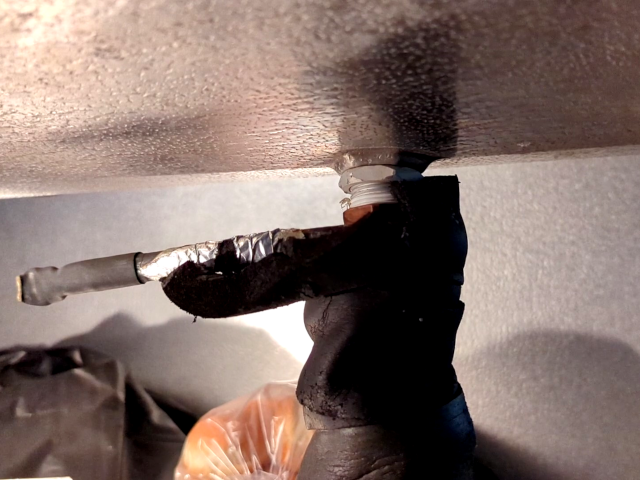
Strip Curtains vs. Air Curtains for Walk-in Coolers
Choosing between strip curtains and air curtains for your walk-in cooler depends on various factors. Both solutions address infiltration issues, which can affect refrigeration efficiency, as noted by experts from Larkin.
Reducing infiltration is crucial for optimal refrigeration system performance. Here’s a look at both options:
Strip Curtains
Strip curtains are a time-tested, budget-friendly solution with no recurring electricity costs or moving parts. They require minimal maintenance—just periodic cleaning—and are easy to install independently.
However, there are some concerns:
- Excess curtain material might prevent the door from closing properly.
- Heavy curtains could dislodge items when supplies are brought in.
Air Curtains
Studies presented to the Department of Energy (DOE) suggest that air curtains can reduce compressor runtime by up to 27%, potentially extending compressor life and reducing service calls.
Choosing between strip curtains and air curtains depends on your needs, budget, and the characteristics of your walk-in cooler. Both options can effectively address infiltration issues, but air curtains may offer additional energy savings.
Time-Based Open Door Alarms
Implementing a time-based open door alarm can significantly improve door management. These alarms remind users to close the door promptly, reducing the frequency of manual reminders from managers. For some, a simple low-cost reminder may suffice, while others might prefer a more advanced system with email notifications.
Consider the door's typical open time; often, it only takes about 20 seconds to open and close. Addressing habits such as leaving the door open for extended periods (sometimes over 30 minutes) is crucial to prevent warm air from entering and overworking your freezer. Using carts or dollies to move supplies efficiently can help keep the door closed and your walk-in freezer operating correctly.
Good Practice for Refrigerated Space
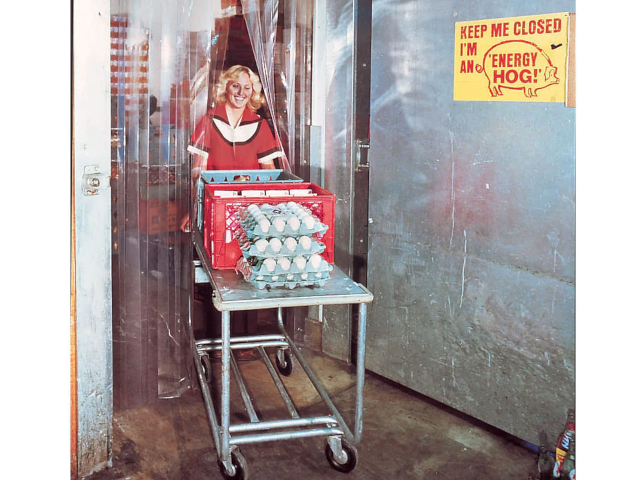
Photo courtesy of plasticstripcurtain.com
Poor Practice for Refrigerated Space
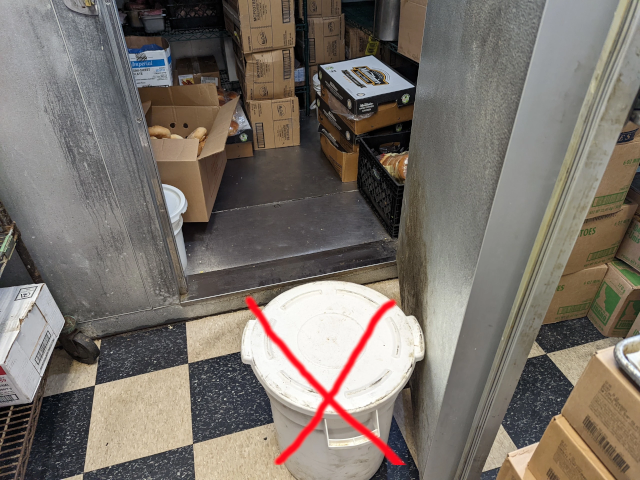
Blocking walk-in cooler doors will raise the average temperature and increases the compressor run time such as the case for this freezer at Montclair
How to Clean Your Walk-In Cooler’s Condenser Coils
Cleaning the condenser coils is essential for keeping your walk-in cooler running efficiently. Follow these straightforward steps:
- Turn off the power to the cooler by unplugging it or switching off the circuit breaker.
- Remove dust and debris around the coils with a vacuum or soft brush.
- Prevent water from coming into contact with electrical components like the fan.
- Spray the coil with water and let it soak for about 3 minutes.
- Apply a mixture of water and mild soap to the coil.
- Allow the solution to sit for 5-10 minutes to break down grime.
- Rinse the coil thoroughly with water 3 to 5 times until it runs clear.
- Let the coil air dry for about 10 minutes or until completely dry.
Tools: Use a light pressure washer, sprayer, or garden hose with moderate pressure to clean the coils without damaging the fins.
Frequency: While manufacturers often recommend cleaning every 60 to 90 days, this might not suit your specific situation. Outdoor units might gather cottonwood or leaves, while indoor units near kitchens can accumulate lint and grease. Monitor your coils monthly for a year to determine the optimal cleaning frequency for your setup. Cleaning them less often, based on your observations, can be more cost-effective.
How to Clean Your Walk-In Cooler’s Evaporator Coils
Maintaining clean evaporator coils is key to ensuring your walk-in cooler operates efficiently. Here’s how to clean them:
- Turn off the power to the cooler by unplugging it or switching off the circuit breaker.
- Remove dust and debris around the coils using a vacuum or soft brush.
- Prevent water from coming into contact with electrical components like the fan.
- Spray the coil with water and let it soak for about 3 minutes.
- Apply a mixture of water and mild soap to the coil.
- Let the solution sit for 5-10 minutes to loosen grime.
- Rinse the coil thoroughly with water 3 to 5 times until it runs clear.
- Allow the coil to air dry for about 10 minutes or until fully dry.
Tools: Use a light pressure washer, sprayer, or garden hose with enough pressure to clean effectively but not damage the fins.
Frequency: Regular cleaning is crucial. While specific recommendations vary, monitoring the coils every 6 to 12 months is a good practice. Adjust the frequency based on observations.
To ensure optimal maintenance, consider scheduling regular cleanings as part of a professional service plan.
Condensing Unit Installation Locations
Choosing the right location for your condensing unit (CU) is crucial for efficient operation. You have three main options: Top Mount, Side Mount, and Remote. Each has its benefits and potential drawbacks.
Top Mount Condensing Unit
Top mount units are pre-assembled and self-contained, much like window air conditioners. Manufacturers like Norlake design these units to integrate smoothly with the interior, saving space. However, when installed indoors, the heat from the compressor can increase the load on your air conditioning system, especially during hot summer months.
Side Mount Condensing Unit
Side mount units are ideal for areas with low ceilings. They are installed on the side of the cooler, but this placement can reduce interior shelf space due to the location of the evaporator coil.
Remote Condensing Unit
Remote condensing units are placed away from the cold room, either outdoors or in a separate indoor location like a basement. This setup helps avoid adding extra heat to the conditioned space and allows for better space utilization. Outdoor units may be installed on roofs or other external locations, while indoor units are usually located in well-ventilated basements.
When deciding whether to purchase a new condensing unit or retrofit your existing cooler, consider the advantages of both indoor and outdoor installations. We recommend indoor installations in well-ventilated basements whenever possible.
Outdoor Condensing Units
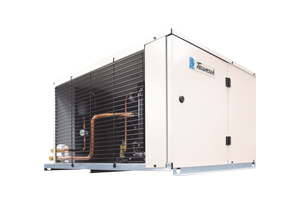
Outdoor units come with weatherproof casing to handle exposure to elements like UV, snow, and rain. However, installing these units can be challenging and costly due to the need for cranes to place them on roofs and the difficulties technicians face working in freezing temperatures.
Indoor Condensing Units
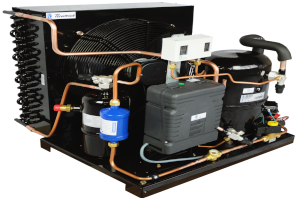
Indoor units are best placed in clean, well-maintained basements. This location reduces repair calls and the frequency of coil cleanings, as the units are shielded from weather conditions. However, be cautious of basement flooding or poor ventilation, which can lead to rust and oxidation.